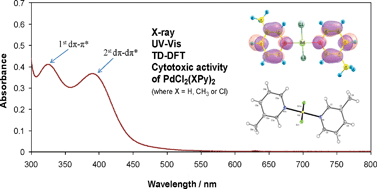Palladium(II) complexes attract great attention due to their remarkable catalytic and biological activity. In the present study X-ray characterization, UV-Vis and Time-Dependent Density Functional Theory (TD-DFT) calculations for six PdCl2(XPy)2 complexes (where: Py = pyridine; X = H, CH3 or Cl) were applied in order to investigate substituent effects on their crystal structures and electronic properties and to combine the results with their catalytic and cytotoxic activity. The structures of complexes PdCl2(3-MePy)2, PdCl2(4-MePy)2 and PdCl2(2-ClPy)2, have been described for the first time and we compared our results with available data for the whole series of six complexes. All compounds exhibit a square planar coordination geometry in which the palladium ion coordinates two nitrogen atoms of pyridine ligands and two chlorine atoms in trans positions. For complexes with ortho substituted XPy ligands a cis disposition of substituents takes place, whereas for other ligands: 3-MePy and 3-ClPy – the substituents are in trans positions. For XPy the energies of π–π* and n–π* transitions depend on the position and nature of the X substituent in the XPy ring. After complex formation a hipsochromic shift (24–34 nm) of π–π* and a bathochromic shift of n–π* bands are observed. The UV-Vis spectra of PdCl2(XPy)2 confirm that square planar coordination geometry of complexes I–VI and two dπ–π* transitions are expected. With the help of the TD-DFT calculations we proved that dπ–π* transitions in solutions of PdCl2(XPy)2 complexes result from MLCT (metal-to-ligand charge transfer) with contribution from chlorine atoms to palladium. We also studied substituent effects on cytotoxic properties of Pd(II) complexes against the human breast cancer cell line MCF7, the human prostate cancer cell line PC3, and the human T-cell lymphoblast-like cell line CCRF. The studied complexes were the most active against the CCRF cell line and less or even no cytotoxic effect was observed for PC3 cells. Complexes with MePy ligands showed increased cytotoxic activity compared to unsubstituted pyridine ligands.

You have access to this article
 Please wait while we load your content...
Something went wrong. Try again?
Please wait while we load your content...
Something went wrong. Try again?


 Please wait while we load your content...
Please wait while we load your content...